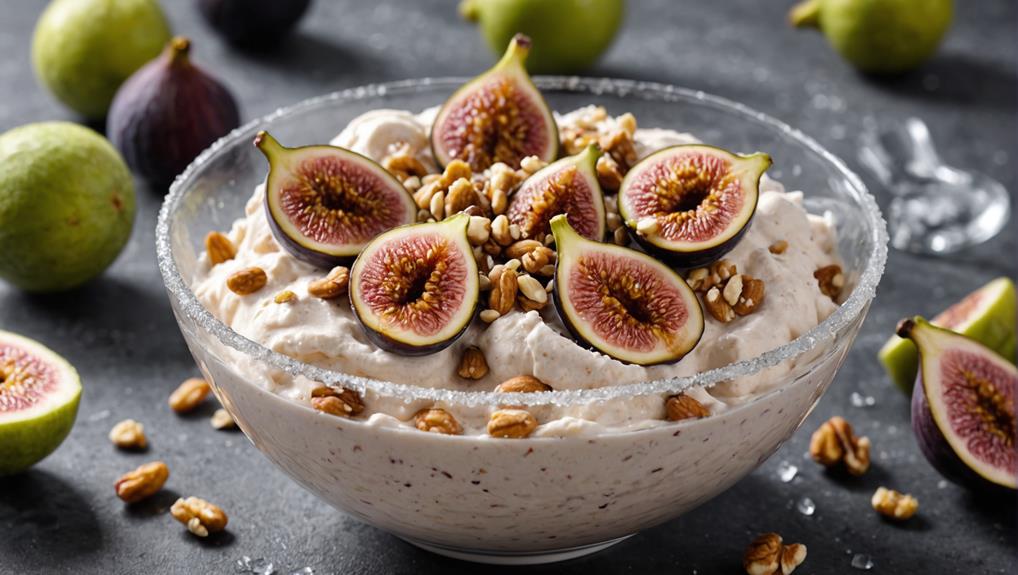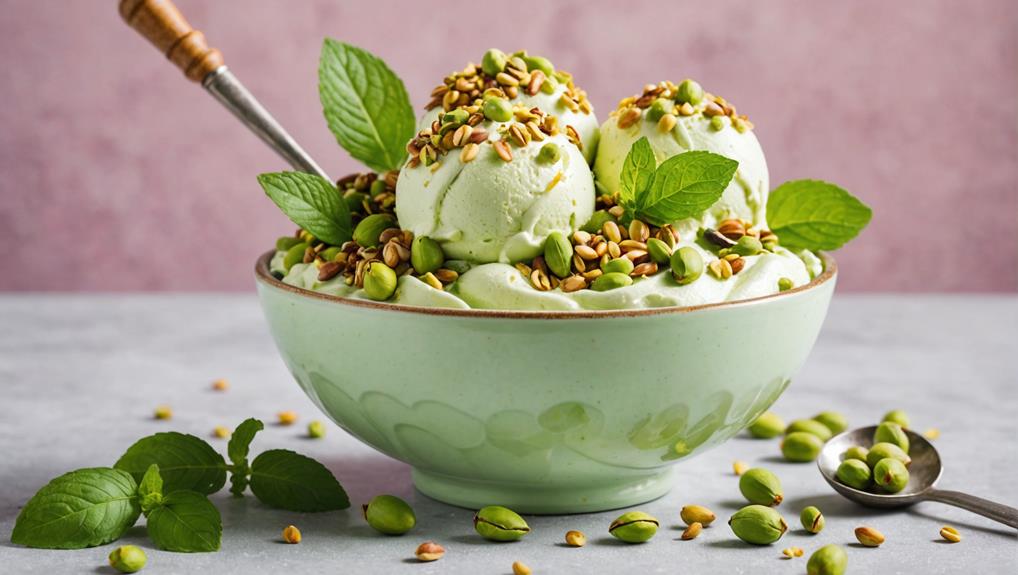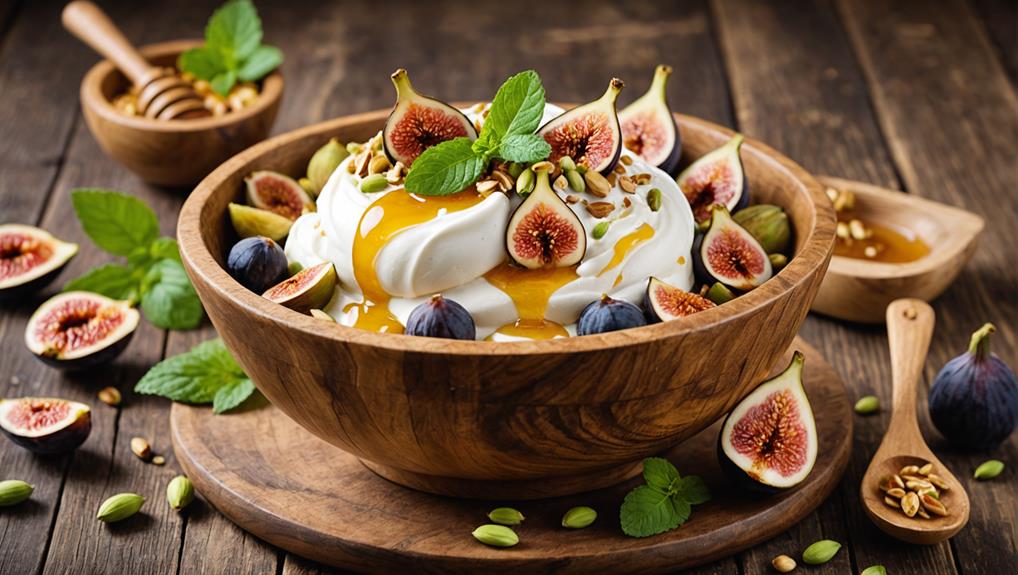Uncover the essence of luxury with fig frozen yogurt, a sophisticated treat merging creamy yogurt with the rich flavor and texture of ripe figs. Choose high-quality figs from local markets to guarantee balanced sweetness. Craft a creamy yogurt base using full-fat or Greek yogurt, sweetened with honey or maple syrup. Integrate a fig puree into the yogurt mixture before churning in an ice cream maker. Enhance the experience with toppings like edible flowers or dark chocolate. Following these steps will produce an exquisite dessert, promising both flavor and elegance. Discover the complete recipe and preparation tips to master this gourmet delight.
Key Takeaways
- Choose high-quality, ripe figs from local markets for balanced sweetness and optimal texture.
- Use full-fat or Greek yogurt for a creamy base and incorporate honey or maple syrup for natural sweetness.
- Heat milk and add a starter culture to prepare the yogurt, then blend in fig puree and flavor enhancers.
- Churn the mixture in an ice cream maker, monitoring texture and adding mix-ins as needed before freezing.
- Enhance the final product with zest, edible flowers, or dark chocolate for a gourmet touch and visual appeal.
Ingredients Needed

Gathering the necessary ingredients is the first step in creating a delicious fig frozen yogurt. The foundation of this gourmet treat lies in meticulously selecting figs that offer a perfect balance of sweetness and texture, which will enhance the overall flavor profile of the dessert. High-quality figs, whether fresh or dried, can notably influence the taste, blending their natural sugars seamlessly into the creamy base.
Equally important is the choice of yogurt. Opt for a high-quality, full-fat yogurt to achieve a rich and creamy texture. Greek yogurt is often preferred for its thick consistency and tangy undertones, which pair beautifully with the inherent sweetness of figs. This yogurt pairing elevates the dessert, providing a harmonious blend of flavors that dance on the palate.
Additionally, consider adding a touch of honey or maple syrup to accentuate the figs' natural sugars without overpowering them. For a burst of freshness, a squeeze of lemon juice can be incorporated, subtly balancing the sweetness with a hint of acidity. Serving ideas for fig frozen yogurt include garnishing with chopped nuts or a drizzle of fig compote, creating a visually appealing and delectable treat.
Choosing the Right Figs
Choosing the right figs for your frozen yogurt is essential for achieving the desired taste and texture. Understanding the various fig varieties and their respective ripeness levels can greatly impact the flavor profile of your dessert. Additionally, sourcing fresh, high-quality figs will guarantee the best results in your culinary creation.
Fig Varieties Explained
Understanding the different varieties of figs is essential for selecting the best type for your frozen yogurt recipe. Different fig varieties offer unique fig health benefits and lend themselves to diverse fig flavor profiles, making them versatile ingredients in desserts. Opting for the right fig can greatly enhance the taste and nutritional value of your gourmet treat.
The table below provides a snapshot of some popular fig varieties, their flavor profiles, and pairing suggestions:
| Fig Variety | Flavor Profile | Pairing Suggestions |
|---|---|---|
| Black Mission | Rich, sweet, and earthy | Dark chocolate, walnuts, honey |
| Kadota | Less sweet, slightly nutty | Goat cheese, prosciutto, balsamic |
| Calimyrna | Nutty with a hint of vanilla | Almonds, vanilla yogurt, cinnamon |
| Adriatic | Sweet with a delicate honey-like taste | Ricotta, lemon zest, fresh berries |
Black Mission figs, with their rich, sweet, and earthy flavor, enhance the depth of your frozen yogurt. Kadota figs are less sweet and slightly nutty, making them perfect for balancing richer ingredients. Calimyrna figs provide a nutty flavor with a hint of vanilla, ideal for pairing with almonds and vanilla yogurt. Adriatic figs, known for their delicate honey-like taste, pair wonderfully with ricotta and fresh berries. Select the fig variety that best complements your yogurt base and intended flavor profile to craft a truly gourmet frozen yogurt experience.
Ripeness and Flavor
The ripeness of figs plays an important role in determining their flavor and texture, which directly impacts the quality of your frozen yogurt. Selecting the right figs can elevate your dessert from ordinary to extraordinary, providing a balance of sweetness and a creamy consistency. Here are three essential considerations when choosing figs for your frozen yogurt:
- Sweet versus Savory: Fully ripe figs tend to be sweeter, making them ideal for desserts such as frozen yogurt. Under-ripe figs, on the other hand, have a less pronounced sweetness and firmer texture, which might not blend as smoothly in your recipe. Opt for figs that yield slightly to pressure and emit a fragrant aroma.
- Health Benefits: Ripe figs are not only tastier but also richer in antioxidants, fiber, and essential nutrients like potassium, calcium, and magnesium. These health benefits make them a nutritious addition to your frozen yogurt, enhancing both flavor and nutritional value.
- Visual Cues: Look for figs with a deep, rich color and minimal blemishes. The skin should be smooth and unbroken, while the stem should be firm yet flexible. Avoid figs that are too soft or have a sour smell, indicating overripeness.
Sourcing Fresh Figs
Selecting the right figs starts with understanding where and how to acquire them for optimal freshness and flavor. Fresh figs are delicate and perishable, making fig preservation methods essential for maintaining their quality. Opt for a farm-to-table approach to guarantee you are receiving the freshest produce. Local markets are often the top spots to find these exquisite fruits, as they frequently offer figs that have been harvested recently.
Understanding the seasonal availability of figs can significantly influence your sourcing strategy. Figs are usually in season from late summer to early fall, although this can vary slightly depending on the region. When shopping for figs, look for fruit that is plump, soft to the touch, and free from bruises or blemishes. The skin should be intact, and a sweet, mild aroma is a good indicator of ripeness.
Here is a quick reference to help you choose the finest figs:
| Criteria | Ideal Characteristics |
|---|---|
| Skin Condition | Intact, smooth, blemish-free |
| Firmness | Slightly soft, not mushy |
| Color | Rich, deep hue |
| Aroma | Sweet, mild fragrance |
Preparing the Figs

To start preparing the figs, first make sure you have selected fresh, ripe specimens for best flavor and texture. Next, thoroughly clean the figs under running water and trim any stems or imperfections. Finally, chop the figs into small pieces suitable for blending into the yogurt mixture.
Selecting Fresh Figs
When selecting fresh figs for your frozen yogurt, make certain they are plump, tender, and free from blemishes or signs of over-ripeness. The quality of figs directly influences the final taste and texture of your gourmet treat, making fruit selection a critical step in fig recipes. Here are a few pointers to make sure you pick the best figs:
- Check for Ripeness: Gently squeeze the fig; it should yield slightly to pressure without being mushy. A perfectly ripe fig will have a slight give, indicating it is juicy and ready to use.
- Inspect the Skin: Look for figs with smooth, unbroken skin. While some minor cracks can be acceptable, avoid figs with significant blemishes or bruises as these can affect the yogurt's texture and flavor.
- Smell the Fruit: Fresh figs should have a mildly sweet aroma. A sour or fermented smell indicates over-ripeness or spoilage, which can negatively impact your frozen yogurt.
Cleaning and Trimming
Properly cleaning and trimming the figs is vital to guarantee the highest quality and safety of your frozen yogurt. To start, gather the equipment needed: a colander, a small sharp knife, and a clean cutting board. Begin by washing the figs under cold running water to remove any dirt or pesticides. Gently rub each fig with your fingers to make sure thorough cleaning. Avoid soaking the figs, as this can lead to water absorption and potential spoilage.
Once cleaned, proceed to the trimming techniques. With the small sharp knife, slice off the stem end of each fig. Inspect the figs for any blemishes or bruises and carefully trim away any damaged areas. This ensures that only the best parts of the figs are utilized in the recipe.
Proper storage tips are also important. If not using the figs immediately, place them in a single layer on a paper towel-lined plate and store them in the refrigerator. This helps maintain their freshness and prevents them from becoming overly soft.
Below is a detailed table outlining equipment, cleaning methods, trimming techniques, and storage tips:
| Step | Equipment Needed | Description |
|---|---|---|
| Washing | Colander, Water | Rinse under cold running water |
| Trimming | Sharp Knife, Cutting Board | Slice off stem and remove blemishes |
| Storage | Plate, Paper Towel | Refrigerate in a single layer |
| Inspection | Sharp Knife | Check for and remove damaged areas |
| Final Prep | Clean Hands | Ensure figs are ready for next steps |
Chopping for Blending
For best blending, figs should be chopped into uniformly small pieces to ensure a smooth incorporation into the yogurt mixture. This precise chopping guarantees that the figs blend seamlessly, avoiding any chunks that could disrupt the creamy texture of the frozen yogurt. The following steps provide an effective method for preparing the figs:
- Fruit Selection: Choose fresh, ripe figs for optimal sweetness and flavor. Overripe or underripe figs can impact the consistency of the final product. Make sure the figs are firm yet yielding to gentle pressure.
- Washing and Drying: Before chopping, wash the figs thoroughly under cold running water to remove any residues. Pat them dry with a clean kitchen towel to prevent excess moisture from diluting the yogurt mixture.
- Chopping Technique: Using a sharp knife, trim the stem ends off the figs. Slice each fig in half lengthwise, then quarter each half. Continue chopping until the pieces are uniformly small, approximately the size of peas. This consistency is essential for a smooth blend.
Making the Yogurt Base
To create the yogurt base, begin by combining high-quality whole milk with a live active culture yogurt starter. This combination is necessary for achieving the desired flavor infusion and best yogurt consistency. For the best results, use fresh, full-fat milk, as it contributes to a richer texture balance and more robust taste.
When preparing the yogurt base, it is essential to heat the milk to 180°F (82°C) to denature the proteins, ensuring a smooth and creamy consistency. Allow the milk to cool to 110°F (43°C) before adding the yogurt starter, as this temperature range is ideal for the cultures to thrive. Gently whisk in the starter to optimize an even distribution of cultures throughout the milk.
Below is a table outlining the key steps and corresponding temperatures for making the yogurt base:
| Step | Temperature | Notes |
|---|---|---|
| Heat the milk | 180°F (82°C) | Denatures proteins for smooth texture |
| Cool the milk | 110°F (43°C) | Best for adding yogurt starter |
| Incubate the mixture | 110°F (43°C) | Maintain temperature for 6-12 hours |
During the incubation period, keep the mixture at a steady temperature to allow the cultures to propagate effectively. Once the yogurt has thickened to your desired consistency, it's ready for the next phase of the recipe.
Combining Ingredients

With the yogurt base prepared, the next step involves incorporating the fig puree and other complementary ingredients to enhance the flavor and texture of the frozen yogurt. Start by gently folding the fig puree into the yogurt base, ensuring an even distribution without overmixing. This will maintain the creamy consistency that is essential for a gourmet treat.
To further elevate your creation, consider the following flavor combinations:
- Honey and Crushed Nuts: Add a drizzle of honey and a handful of crushed pistachios or almonds for a delightful crunch and a touch of natural sweetness.
- Citrus Zest and Mint: Incorporate a teaspoon of lemon or orange zest along with finely chopped mint leaves to introduce invigorating, aromatic notes.
- Spices: A dash of cinnamon or cardamom can complement the fig's natural sweetness, adding warmth and complexity to the flavor profile.
These combinations not only enhance taste but also contribute to the nutritional benefits of the dish. Nuts provide protein and healthy fats, while citrus zest adds a boost of vitamin C.
For ideal storage, transfer the mixture into an airtight container and place it in the coldest part of your freezer. This helps maintain the texture and flavor, ensuring a perfect gourmet treat every time.
Churning the Mixture
Initiate the churning process by pouring the fig and yogurt mixture into an ice cream maker, confirming it is properly assembled and prepped for use. Attention to temperature control is pivotal during this stage, as maintaining the best cold environment will guarantee smooth and creamy consistency. Regular texture testing is recommended to monitor the progress and achieve the desired creamy texture.
Equipment maintenance plays an important role in the quality of the churning process. Ensure the ice cream maker is clean and functioning correctly before use. Any residue or malfunction can negatively impact the final product. A well-maintained machine operates more efficiently, contributing to the overall texture and flavor profile of the frozen yogurt.
For those interested in flavor experimentation, this stage offers an excellent opportunity. Consider adding mix-ins such as chopped nuts, honey, or additional fig pieces during the final minutes of churning. This allows for an even distribution of flavors and textures without compromising the yogurt's structure.
Freezing Tips

Guaranteeing ideal freezing conditions is vital for achieving the perfect texture and flavor in your fig frozen yogurt. Proper handling during the freezing process can make a significant difference in the final product's quality. Here are some expert tips to secure your fig frozen yogurt turns out as intended:
- Optimal Temperature: Set your freezer to the coldest setting, ideally around -20°C (-4°F). This rapid freezing helps in minimizing the formation of ice crystals, securing a smooth and creamy texture.
- Proper Storage: Use an airtight container to prevent freezer burn and maintain fig preservation. For best results, place plastic wrap directly on the surface of the yogurt before sealing the lid. This method reduces air exposure, maintaining the yogurt's freshness and flavor.
- Consistent Freezing: Place the container in the coldest part of your freezer, away from the door, to secure consistent freezing. Avoid frequent opening of the freezer, as temperature fluctuations can affect the texture.
Preserving the figs' nutritional integrity, which includes high levels of dietary fiber, potassium, and antioxidants, is essential. Following these storage tips will maximize the fig health benefits and maintain their nutrition facts, securing a delightful and healthful frozen treat.
Serving Suggestions
Having mastered the freezing process, elevate your fig frozen yogurt experience with creative and delicious serving suggestions. Start with presentation ideas that transform your dessert into a visual feast. Serve the yogurt in elegant parfait glasses, or for a rustic touch, use mason jars. Enhance the aesthetics by layering the yogurt with alternating swirls of honey or fig compote.
When it comes to flavor pairings, consider complementary tastes that enhance the fig's natural sweetness. Fresh fruits such as raspberries, blueberries, and sliced peaches add vibrant color and a invigorating contrast. For a more decadent approach, incorporate a drizzle of balsamic glaze or a sprinkle of sea salt to accentuate the yogurt's complexity.
In terms of toppings and garnishes, the possibilities are endless. Crushed pistachios or slivered almonds provide a delightful crunch, while a dusting of freshly grated lemon zest adds a zesty brightness. For a touch of luxury, top the yogurt with edible flowers or a few shavings of high-quality dark chocolate.
Frequently Asked Questions
Can I Use Dried Figs Instead of Fresh Ones?
Yes, you can use dried figs instead of fresh ones. However, be aware that different fig varieties may affect the taste difference and nutritional value. Rehydrating dried figs beforehand is recommended for best texture and flavor integration.
How Long Does Fig Frozen Yogurt Last in the Freezer?
The shelf life of fig frozen yogurt in freezer storage typically ranges from 1 to 2 months. To maintain peak quality, make sure it is stored in an airtight container to prevent freezer burn and preserve its flavor.
Is Fig Frozen Yogurt Suitable for People With Lactose Intolerance?
Fig frozen yogurt may not be suitable for individuals with lactose intolerance. However, lactose-free options are available, offering gut-friendly desserts that accommodate dietary restrictions without compromising on taste or quality.
What Are Some Vegan Alternatives for This Recipe?
Understanding concerns about taste, vegan alternatives such as coconut or almond milk can replace dairy. Enhance flavor with vegan toppings like fresh figs and agave syrup. These dairy-free options guarantee a delightful and inclusive treat.
Can I Add Other Fruits to the Fig Frozen Yogurt?
Certainly, incorporating other fruits can enhance the dish through diverse fruit combinations, texture variations, and vibrant flavor profiles. Additionally, creative presentation ideas will elevate the visual appeal and gastronomic experience of the frozen yogurt.
Conclusion
The gourmet fig frozen yogurt recipe offers a sophisticated blend of creamy yogurt and the unique sweetness of fresh figs. With figs being a rich source of dietary fiber, providing approximately 5 grams per serving, this dessert not only delights the palate but also contributes to digestive health. Proper preparation and meticulous selection of ingredients secure a high-quality treat. The meticulous process from fig selection to final freezing guarantees a gourmet experience worthy of refined tastes.







